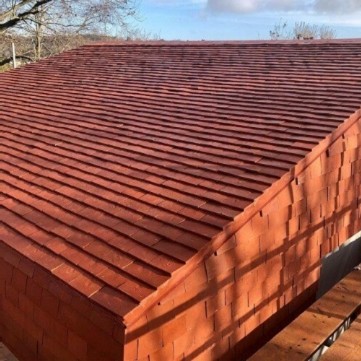Traditional clay tiles in Buckinghamshire
Heritage Tiles: Emblematic of the finest craftsmanship
Heritage tiles are the professional roofer's choice for the highest quality clay roof tiles. We pride ourselves in manufacturing, stocking, and delivering the very finest in prestige clay roof tiles.
Heritage Tiles have several tile ranges that satisfy every architectural requirement. Vintage and historic properties right up to modern new builds are covered by the diverse range of clay roof tiles that we stock.
So, whether you are in the building trade, or simply wish to choose your own tiles, Heritage Tiles have the right product for your specific requirements.
What Heritage Tiles have to offer our customers?
- We offer specification and technical solutions to help you achieve the perfect build.
- We also offer expert design advice to all our customers.
- We are happy to engage in site visits with our clients.
- We have stockists and distributors throughout the United Kingdom to ensure that we can provide our expert service to a wider area.
- We can provide estimated quantities from plans supplied by our clients.
- We offer battening plans.
- We can deliver a standard and bespoke colour choice for our clay tile products.
- All our tiles are assessed and approved by Lucideon.
- We provide a nationwide delivery and collection service.
The ranges of clay roof tiles we supply.
The Clayhall Range of roof tiles:

Clayhall Medium Blend - Carefully crafted to replicate all the features of handmade the Clayhall hand crafted range of tiles offers an excellent alternative when budget restrictions are a concern, but without compromising quality or durability.
Clayhall Dark Blend - Quality and durability in a budget clay roof tile. The Clayhall dark blend is sure to turn heads.
Clayhall Red Blend - A beautiful rustic clay roof tile. The Clayhall red blend is a firm favourite with our customers.
Clayhall Hamlet Mix - The Clayhall Hamlet mix is a gorgeous light and sandy looking clay roof tile that is a perennial favourite in the building trade.
Clayhall Birchwood Mix - The Clayhall Birchwood mix offers a gorgeous blend of lighter and darker shades in this diverse clay roof tile. If you are concerned that your roof tiles could look monotonous, the Clayhall Birchwood mix is the clay roof tile to choose.
The Conservation Range of roof tiles

The Conservation range of roof tiles are available in a range of distinctive colours, created by using a very fine sand, The Conservation Weathered; A natural warm tone, achieving an instant mellow and settled look and The Conservation Red; perfect for vertical tiling especially suited for villages and hamlets with olde world vernacular charm.
Manufactured using high quality clay, achieving high strength and durability properties, giving homeowners and contractors peace of mind for many years to come. The conservation range comes with a complete set of associated fittings, including Hog Back Ridge, Half Round Ridge, Bonnet Hips, Valley tiles and External Angles.
The Conservation range of clay roof tiles comes in the following variations:
- Conservation Red
- Conservation Weathered
- Conservation Dark
Conservation Peg Tile
Plain clay roofing tiles laid to a double lap have been used for roof covering in England since before the Norman Conquest and tiles dating back to Roman Times have been discovered under excavation. From the outset clay plain tiles were made incorporating fixing features.
The Classic Edwardian roof tile
The Classic range of plain tiles is one of the finest ranges of clay tiles.
We source only the best raw materials for our craftsman to create beautifully handmade clay tiles of the highest quality and durability.
Tile Fittings available from Heritage Tiles
There are many fittings that are available from us a Heritage Tiles to complete your build to perfection. We stock and supply the following:
- Gable Tile
- Eave Tile
- Baby Porch Ridge
- 90 Degree Ext. Angle
- Universal Bonnet Hip
- Half Round Ridge
- Hogs Back Ridge
- Mono Ridge
- Third Round Ridge
- Universal Valley
- Ornamental Club
- Bat Tile Set
Bat Tiles:
Provide help for our bats with our range of bat friendly roof tiles.
Did you know that all UK bats and their roosts are protected by law? The Wildlife and Countryside Act introduced in 1981, gave legal protection to all bat species and their roosts in England.
Distinct species of bats prefer differing places to roost. The two most usually found species of bat in the UK are the Pipistrelle and Brown Long-Eared Bat. Pipistrelle prefer confined spaces such as under tiles on roofs and hanging spaces. The Brown Long-Eared Bat prefer roof timbers and ridges inside lofts. Heritage Clay Tiles can provide purpose made access points within your roof tiles or ridge tiles. The Bat Tile Set can form part of a mitigation package required by law for existing roosts or as potential access where a roost had not previously been present.
Select a Blend
Getting the right blend for your roofing project can feel daunting, but with our blend generator you can mix and match various blends of tiles to achieve the perfect blend.
Click here to make use of our online tool to choose your own unique blend.
Because our strict quality control provides a consistent tile size you can mix assorted styles and colours of tiles to make your roof unique to you. Please use the tool below to experiment with various blends.
Adjust the sliders to set the ingredients for your desired blend then click on the update mix button.
Alternatively click on any blend or tile to display it.
Whatever type of clay roof tile you want, Heritage Tiles will be able to help.
Traditional clay tiles
Traditional clay tiles are the best choice of roofing
Clay roof tiles have been used as roof coverings for a very long time. In fact, archaeologists have found evidence of clay roof tiles in China dating back as far as 10,000 BC. When the Romans landed in Britain during the first century AD, they brought the tradition of using clay roof tiles with them, and they used them to cover their villas, temples and bathhouses.
A disaster brings traditional clay tiles to the forefront of construction
Traditional clay tiles didn't really become popular until after the Great Fire of Southwark in 1212. Following the fire, King John made a proclamation, stating that buildings in London should be built with clay roof tiles, rather than thatched roofing, since they were more resistant to fire.
For most of their history, clay tiles have been made by hand in a rather laborious and time consuming process. These days, you can still get handcrafted tiles for that traditional finish, or choose from products that are made by machines for a faster result, more uniform appearance and a more affordable price.
Whether you opt for tiles that are handmade or made by a machine, the traditional clay roof tiles that are manufactured today also conform to modern building standards and can be used in dry-fix roofing systems, meaning they can be installed quickly and securely while providing the look that we all want for our properties.
Traditional clay tiles come in both plain clay tiles and profiled pantiles in a range of shapes and colours. This ensures you can easily find a product that suits your design requirements. These offer the classic good looks of traditional clay tiles, but with the benefits of modern manufacturing techniques and very easy installation.
Modern alternatives to Heritage Clay Tiles Ltd traditional clay tiles
Modern technology has opened up the market for new materials and innovations to be used in the manufacturing process, such as fibre cement.
In today's climate of recycling and sustainability, we have seen a clear trend moving towards building materials that can improve the sustainability and carbon efficiency of construction projects. With an ambitious government aim for net carbon zero by 2050 and all new homes to be zero-carbon ready by 2025, roofing manufacturers are looking at more ways in which their products can align to this vision.
When you consider that traditional clay tiles are made from natural and recyclable materials, it's easy to see why they still remain at a front runner in the roofing industry.
Traditional clay tiles or a modern alternative?
Realistically, it all boils down to your personal choice of roofing material. In fact, you can achieve a traditional or contemporary style while enjoying the benefits of advanced and modern materials, manufacturing techniques and installation options. That means you can base your decision on factors such as how the roof is designed, how durable it is, how it looks and your budget.
When considering the appearance of your roofing tile, remember to think about whether you want the building to stand out or blend in with its surroundings, and then take a look at your geographic location and what's in general use around you. Remember, being different isn't always a good look and could land you in hot water with the local authorities if you choose a roofing material that is too outlandish. You could also be forced to rectify any planning breaches at great personal expense. Traditional clay tiles are always a much safer option, always look great and are known to stand the test of time.
A little information about Buckinghamshire
Wendover in Buckinghamshire
Wendover is a market town and civil parish at the foot of the Chiltern Hills in Buckinghamshire. It is situated at the point where the main road across the Chilterns between London and Aylesbury intersects with the once important road along the foot of the Chilterns. The Buckinghamshire town is only thirty five miles North West of London and is very popular with commuters working in London.
The Buckinghamshire parish has an area of 5,832 acres and had, at the time of the 2011 census, a population of 7,399. Outside the town of Wendover, the parish is mainly arable and also contains many hamlets that rest amongst the ancient woodlands on the surrounding hills. Although Wendover has a weekly market, and has had a market charter since medieval times, many of its inhabitants identify it as a village, and the parish council does not describe itself as a town council.
Where the Buckinghamshire town got its name from
The name of this Buckinghamshire town is of Brythonic Celtic origin. The first element, wen can mean "blessed" or "white". The second element, dussr or dwfr simply means water.
As such, the meaning of Wendover is often given as "White-water", and likely refers to the chalky stream that flows through the middle of the Buckinghamshire town. This stream rises in the adjacent hills, bringing white chalk deposits with it. The Buckinghamshire town has an abundance of spring water, which gave rise to the alternative interpretation of the town name as "Blessed-water", but this has never been officially accepted.
History of Wendover in Buckinghamshire
The first known documentary reference to Wendover in Buckinghamshire, then known as Waendofron, is in the will of Aelfheah, the ealdorman of Hampshire, and dates from between 965 and 971. Prior to the Norman Conquest, the manor, which at the time measured twenty four hides in area, was held by Edward the Confessor. The Buckinghamshire settlement appears to have been centred some 2,000 ft to the south of the present-day focus of the town, near the current location of the parish church of St Mary. By 1086, the manor of Wendovre was in the hundred of Aylesbury, with William the Conqueror as its tenant in chief.
The Buckinghamshire manor remained in royal ownership until 1154, and then passed back and forth between royal and private ownership several times. Wendover was granted a market charter in 1214, and had become a borough by 1228, although it does not appear to have achieved any degree of self-government.
The Civil war comes to Buckinghamshire
Both parliamentary and royalist forces visited the Buckinghamshire town during the Civil War, with looting reported by both sides. Many of the buildings in the town centre, and especially on High Street, Pound Street, and Aylesbury Road, dates from the 17th century. It is not known whether this is because they needed rebuilding after civil war damage, or is an indication of the prosperity of the town at the time.
In 1913, Alfred de Rothschild, invited the Royal Flying Corps to conduct manoeuvres on his land in the adjacent manor of Halton, and this Buckinghamshire land continued to be used by the British Army throughout the First World War. In 1916 the Royal Flying Corps moved its air mechanics school from Farnborough, Hampshire to Halton, and in 1917, and the school was permanently accommodated there, in what was to become the current RAF Halton. Whilst the base is not in the parish of Wendover, its close proximity impacted on the town, and the surrounding Buckinghamshire landscape, due to the associated population increases and deforestation to provide wood for construction work.
Products available from Heritage Clay Tiles Ltd in East Sussex
Clay Roof Tiles in East Sussex
Clayhall Roof Tiles in East Sussex
Conservation Roof Tiles in East Sussex
Edwardian Roof Tiles in East Sussex
Victorian Roof Tiles in East Sussex
Georgian Roof Tiles in East Sussex
Handmade Clay Tiles in East Sussex
Handmade Roof Tiles in East Sussex
High Quality Roof Tiles in East Sussex
Traditional clay tiles in East Sussex
Traditional roof tiles in East Sussex
Products available from Heritage Clay Tiles Ltd in Essex
Conservation Roof Tiles in Essex
High Quality Roof Tiles in Essex
Traditional clay tiles in Essex
Traditional roof tiles in Essex
Products available from Heritage Clay Tiles Ltd in Hampshire
Clayhall Roof Tiles in Hampshire
Conservation Roof Tiles in Hampshire
Edwardian Roof Tiles in Hampshire
Victorian Roof Tiles in Hampshire
Georgian Roof Tiles in Hampshire
Handmade Clay Tiles in Hampshire
Handmade Roof Tiles in Hampshire
High Quality Roof Tiles in Hampshire
Traditional clay tiles in Hampshire
Traditional roof tiles in Hampshire
Products available from Heritage Clay Tiles Ltd in Hertfordshire
Clay Roof Tiles in Hertfordshire
Clayhall Roof Tiles in Hertfordshire
Conservation Roof Tiles in Hertfordshire
Edwardian Roof Tiles in Hertfordshire
Victorian Roof Tiles in Hertfordshire
Georgian Roof Tiles in Hertfordshire
Handmade Clay Tiles in Hertfordshire
Handmade Roof Tiles in Hertfordshire
High Quality Roof Tiles in Hertfordshire
Traditional clay tiles in Hertfordshire
Traditional roof tiles in Hertfordshire
Products available from Heritage Clay Tiles Ltd in Kent
Conservation Roof Tiles in Kent
High Quality Roof Tiles in Kent
Traditional clay tiles in Kent
Traditional roof tiles in Kent
Products available from Heritage Clay Tiles Ltd in London
Conservation Roof Tiles in London
Edwardian Roof Tiles in London
Victorian Roof Tiles in London
High Quality Roof Tiles in London
Traditional clay tiles in London
Traditional roof tiles in London
Products available from Heritage Clay Tiles Ltd in Surrey
Conservation Roof Tiles in Surrey
Edwardian Roof Tiles in Surrey
Victorian Roof Tiles in Surrey
High Quality Roof Tiles in Surrey
Traditional clay tiles in Surrey
Traditional roof tiles in Surrey
Products available from Heritage Clay Tiles Ltd in West Sussex
Clay Roof Tiles in West Sussex
Clayhall Roof Tiles in West Sussex
Conservation Roof Tiles in West Sussex
Edwardian Roof Tiles in West Sussex
Victorian Roof Tiles in West Sussex
Georgian Roof Tiles in West Sussex
Handmade Clay Tiles in West Sussex
Handmade Roof Tiles in West Sussex
High Quality Roof Tiles in West Sussex
Traditional clay tiles in West Sussex
Traditional roof tiles in West Sussex
Products available from Heritage Clay Tiles Ltd in Bedfordshire
Clay Roof Tiles in Bedfordshire
Clayhall Roof Tiles in Bedfordshire
Conservation Roof Tiles in Bedfordshire
Edwardian Roof Tiles in Bedfordshire
Victorian Roof Tiles in Bedfordshire
Georgian Roof Tiles in Bedfordshire
Handmade Clay Tiles in Bedfordshire
Handmade Roof Tiles in Bedfordshire
High Quality Roof Tiles in Bedfordshire
Traditional clay tiles in Bedfordshire
Traditional roof tiles in Bedfordshire
Products available from Heritage Clay Tiles Ltd in Berkshire
Clayhall Roof Tiles in Berkshire
Conservation Roof Tiles in Berkshire
Edwardian Roof Tiles in Berkshire
Victorian Roof Tiles in Berkshire
Georgian Roof Tiles in Berkshire
Handmade Clay Tiles in Berkshire
Handmade Roof Tiles in Berkshire
High Quality Roof Tiles in Berkshire
Traditional clay tiles in Berkshire
Traditional roof tiles in Berkshire
Products available from Heritage Clay Tiles Ltd in Buckinghamshire
Clay Roof Tiles in Buckinghamshire
Clayhall Roof Tiles in Buckinghamshire
Conservation Roof Tiles in Buckinghamshire
Edwardian Roof Tiles in Buckinghamshire
Victorian Roof Tiles in Buckinghamshire
Georgian Roof Tiles in Buckinghamshire
Handmade Clay Tiles in Buckinghamshire
Handmade Roof Tiles in Buckinghamshire
High Quality Roof Tiles in Buckinghamshire
Traditional roof tiles in Buckinghamshire
Products available from Heritage Clay Tiles Ltd in Cambridgeshire
Clay Roof Tiles in Cambridgeshire
Clayhall Roof Tiles in Cambridgeshire
Conservation Roof Tiles in Cambridgeshire
Edwardian Roof Tiles in Cambridgeshire
Victorian Roof Tiles in Cambridgeshire
Georgian Roof Tiles in Cambridgeshire
Handmade Clay Tiles in Cambridgeshire
Handmade Roof Tiles in Cambridgeshire
High Quality Roof Tiles in Cambridgeshire
Traditional clay tiles in Cambridgeshire
Traditional roof tiles in Cambridgeshire
Products available from Heritage Clay Tiles Ltd in Oxfordshire
Clay Roof Tiles in Oxfordshire
Clayhall Roof Tiles in Oxfordshire
Conservation Roof Tiles in Oxfordshire
Edwardian Roof Tiles in Oxfordshire
Victorian Roof Tiles in Oxfordshire
Georgian Roof Tiles in Oxfordshire
Handmade Clay Tiles in Oxfordshire
Handmade Roof Tiles in Oxfordshire
High Quality Roof Tiles in Oxfordshire
Traditional clay tiles in Oxfordshire
Traditional roof tiles in Oxfordshire
Products available from Heritage Clay Tiles Ltd in Suffolk
Clayhall Roof Tiles in Suffolk
Conservation Roof Tiles in Suffolk
Edwardian Roof Tiles in Suffolk
Victorian Roof Tiles in Suffolk
Georgian Roof Tiles in Suffolk
Handmade Clay Tiles in Suffolk
Handmade Roof Tiles in Suffolk
High Quality Roof Tiles in Suffolk
Traditional clay tiles in Suffolk
Traditional roof tiles in Suffolk
Further Information
If you would like to know more or are interested in a quote we would be happy to help. Phone us on 01634 471 344, email us at sales@heritagetiles.co.uk and we will be in touch as soon as possible.







